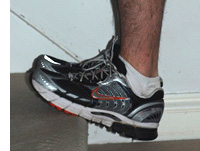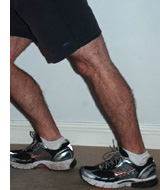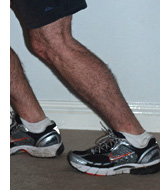Stretching exercises are often effective in the treatment of Achilles tendinopathy, more so in non insertional tendinopathy. They take time to be effective (often up to 3 months) and it is therefore important to persist with them. It should also be remembered that tight calf muscles have been implicated in the development of a number of foot and ankle conditions, so these stretches should help in trying to prevent these. The exercises that should be performed are shown in the photos.

i. Eccentric stair stretch
Eccentric exercises have been found to be the most effective (lengthening of the muscle while it contracts).
The muscles that are most often tight are the gastrocnemius muscles, these can be stretched by standing on a stair balancing yourself using the banister or the wall position your toes on the edge of the step. First rise up on to tip toes using the non painful leg and then drop your heel down whilst standing on the affected leg only (this bends the foot up), this stretch should be performed with the knee straight (it is also useful to perform this with the knee bent- this stretches the deeper soleus muscle).
These stretches should be performed in three sets of 15 stretches. This routine should be performed twice a day.
If you have difficulty performing the stair stretches alternatives are listed below:

ii. Standing Stretch
This is another stretch for the gastrocnemius muscles: standing with your feet pointing forwards (wearing shoes with orthotics in them if you usually wear them), resting your hands against a wall, if you have a painful right heel then this leg should be positioned slightly behind the left and the ankle is bent forward, it is important to KEEP YOUR KNEE STRAIGHT.

iii. Sitting Stretch
This is a further stretch for the gastrocnemius: whilst sitting with your legs straight out in front of you, loop a theraband or a towel or dressing gown cord underneath your foot, then gradually use it to pull your foot towards you KEEPING YOUR KNEE STRAIGHT.

iv. Soleus Stretches
This muscle can be stretched using the stretches above while allowing the knee to bend, this often allows the ankle to bend upwards further.
